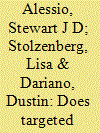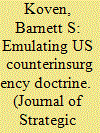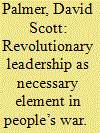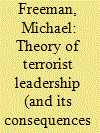|
|
|
Sort Order |
|
|
|
Items / Page
|
|
|
|
|
|
|
| Srl | Item |
| 1 |
ID:
158962


|
|
|
|
|
| Summary/Abstract |
In June 2016, the Colombian Government and the FARC insurgent movement signed a ceasefire agreement, which brings the two sides one step closer to putting an end to over five decades of war. Unfortunately, Latin America has a rich history of insurgent movements, particularly during the cold war era, some of which continue to operate today. Most of these movements disappeared due to military operations, though some did so via peace negotiations. This essay aims to discuss the various ends of Latin American insurgencies to answer whether, indeed, insurgents can be negotiated with.
|
|
|
|
|
|
|
|
|
|
|
|
|
|
|
|
| 2 |
ID:
134445


|
|
|
|
|
| Summary/Abstract |
From January 1979 to December 2009, the Maoist insurgent Shining Path committed a total of 9,034 violent acts in a concerted attempt to topple the Peruvian government. These acts of violence included bombings, armed assaults, and assassinations. The Shining Path's leader Abimael Guzmán was captured by the Peruvian government on 12 September 1992. Using quarterly data and an interrupted times-series AutoRegressive Integrative Moving Average (ARIMA) study design, we investigated the effect of Abimael Guzmán's capture on the ability of the Shining Path to wage its war against the Peruvian government. Maximum-likelihood results revealed that the frequency of terrorist acts committed by the Shining Path dropped by 143 incidents per quarter a short time after Guzmán was captured. The analysis also evinced a positive relationship between the lethality of attacks and the frequency of the Shining Path's terrorist activity. We conclude that targeted capture shows some promise as an effective counterterrorism strategy, at least for terrorist groups such as the Shining Path that have a top-down type of organizational structure.
|
|
|
|
|
|
|
|
|
|
|
|
|
|
|
|
| 3 |
ID:
148223


|
|
|
|
|
| Summary/Abstract |
Recent US advances in counterinsurgency doctrine have been adopted by developing country armed forces. Nevertheless, no systematic study has examined the barriers they face to implementing highly involved counterinsurgency strategy. Tracing the evolution of Peruvian doctrine demonstrates that Peru was able to quickly improve the unity of effort, intelligence capacity, and military basing to meet the demands of a population-centric hearts-and-minds approach to counterinsurgency. Nevertheless, the limited tactical initiative and flexibility of Peruvian forces remains a challenge. The Peruvian experience is instructive for other militaries undergoing similar transitions. However, given the diversity of insurgent conflicts, this doctrine is not universally appropriate.
|
|
|
|
|
|
|
|
|
|
|
|
|
|
|
|
| 4 |
ID:
152959


|
|
|
|
|
| Summary/Abstract |
Though it is well understood that all internal upheaval within a polity is a consequence of agency interacting with structure, the importance of the former has perhaps become too pushed to the rear. In reality, as demonstrated by the case of Sendero Luminoso (Shining Path) in Peru, even cases which seem most determined by structural factors, in practice remain problematic, absent necessary revolutionary leadership. This leadership in turn, can make mistakes just as it guides successes.
|
|
|
|
|
|
|
|
|
|
|
|
|
|
|
|
| 5 |
ID:
133543


|
|
|
|
|
| Publication |
2014.
|
| Summary/Abstract |
States often target terrorist leaders with the belief that the leader's death or capture will cause the terrorist organization to collapse. Yet the history of this strategy of "leadership targeting" provides a mixed record-for every example of effectiveness, there are similar examples of ineffectiveness. The central question of this article is: what makes a terrorist leader important? Specifically, what does a terrorist leader do that no one else can do (or do as well) for the organization? To answer this question, I develop a theory of terrorist leadership that argues that leaders might potentially perform two main functions: they can provide inspiration and/or operational direction (or not for both). I also theorize as to how and why the provision of these functions changes over time as the organization itself changes. The consequences for leadership targeting flow naturally from this theory-when leaders provide these functions to the organization, leadership targeting is most likely to be effective. Case studies of Algeria, Peru, and Japan offer insights into why some cases of leadership targeting were effective and why others were not. The conclusion extends this model with an analysis of al-Qaeda's prospects after the death of bin Laden.
|
|
|
|
|
|
|
|
|
|
|
|
|
|
|
|
|
|
|
|
|